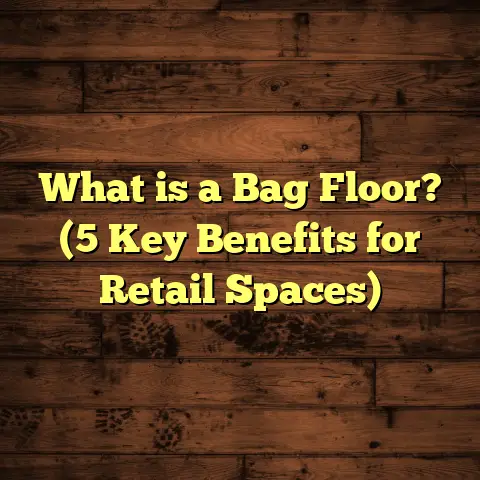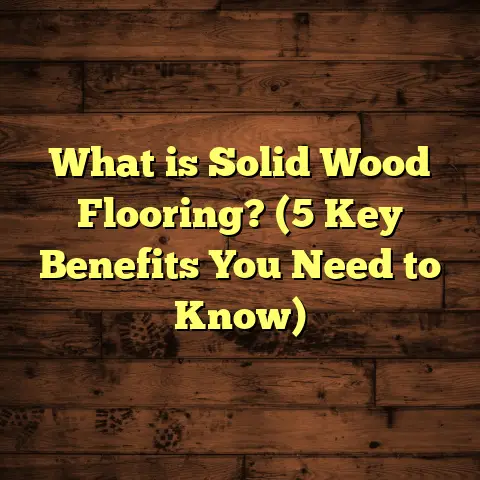What is Brown Paper Flooring? (5 Benefits You Didn’t Know!)
According to a recent survey by Houzz, nearly 43% of homeowners say protecting their floors during home improvements is a top priority. When I first came across this stat, it really hit home because protecting flooring is something I’ve dealt with extensively over the years. Floors are a significant investment—you want to keep them looking great while work is going on. That’s where brown paper flooring comes into play. It’s a simple yet surprisingly effective product that many people overlook. But trust me, it deserves a spot on your list if you’re planning any renovation or moving project.
What is Brown Paper Flooring?
So, what exactly is brown paper flooring? It’s essentially heavy-duty kraft paper designed as a protective cover for floors during construction, remodeling, painting, or even moving furniture. Unlike plastic sheets or fabric drop cloths, brown paper flooring is thicker and sturdier. It absorbs minor spills and provides a shield against scratches, dirt, and debris without trapping moisture underneath.
When I first started working in flooring and remodeling, I mostly saw people using plastic tarps or canvas sheets to protect floors. But after trying brown paper flooring on several projects, I noticed it often performed better by being less slippery, easier to apply, and cleaner to remove. Because it’s made from natural wood pulp, it also doesn’t leave behind residues like some plastics do. This makes it ideal for hardwood floors, laminate, tile, vinyl, and even carpeted areas when combined with other protective layers.
How Brown Paper Flooring Works
Brown paper flooring comes in wide rolls—typically 36 to 48 inches wide and available in lengths from 50 to 150 feet or more. You roll it out over the floor surface and secure the edges with painter’s tape or masking tape. Some versions come with adhesive backing or laminated polyethylene on one side for extra moisture protection.
Its porous structure allows the floor beneath to breathe, which prevents moisture buildup—a common issue with plastic coverings. It’s thick enough to resist tearing from foot traffic or light impacts but still flexible enough to conform to corners and edges easily.
I remember a project where we used reinforced brown paper with a polyethylene layer for a commercial office renovation. The client was worried about heavy equipment damaging the new hardwood floors. The reinforced paper held up impressively well, saving thousands in potential repairs.
5 Benefits You Didn’t Know About Brown Paper Flooring
Now let me share five benefits of brown paper flooring that aren’t widely known but really make a difference.
1. Eco-Friendly and Biodegradable
Many people assume all floor protection products are plastic-based and harmful to the environment. That’s not the case with brown paper flooring. Since it’s made from natural wood pulp and unbleached kraft paper, it biodegrades quickly compared to synthetic alternatives.
In fact, according to data from the Environmental Paper Network, kraft paper breaks down 60% faster than polyethylene plastic. This means if you’re renovating with sustainability in mind, brown paper flooring offers a greener option that reduces landfill waste.
I switched several clients to brown paper flooring after learning about its eco-friendly properties. One of my favorite stories involves a homeowner who was passionate about sustainability. She was remodeling her kitchen and wanted to avoid plastics as much as possible. Using brown paper flooring gave her peace of mind that her project would be both safe for her floors and the planet.
2. Superior Breathability Prevents Moisture Damage
Moisture is one of the biggest enemies of flooring during construction or remodeling. Plastic sheets can trap moisture underneath, leading to mold or warping—especially in hardwood floors. Brown paper flooring’s porous nature lets air circulate while still protecting against dust and spills.
On a recent job site, we were replacing kitchen cabinets in a historic home with delicate hardwood floors. We needed floor protection that wouldn’t trap humidity during the week-long project. Brown paper flooring worked perfectly by absorbing small amounts of moisture from spills and allowing the floor to breathe.
This breathability factor also reduces condensation issues, which can be costly to fix later if ignored.
3. Cost-Effective Without Sacrificing Protection
If you think protecting floors means buying expensive mats or plastic films, think again. Brown paper flooring is one of the most affordable options available per square foot while still offering excellent protection.
From my experience working on dozens of projects—both residential and commercial—I’ve seen budget savings of up to 30% when switching from plastic sheeting to brown paper flooring without compromising safety.
For contractors managing multiple jobs or homeowners doing DIY renovations on a tight budget, this cost difference can be significant.
4. Easy Application and Removal Saves Time
Time is money, right? Applying floor protection shouldn’t slow you down or create extra cleanup headaches. Brown paper flooring rolls out smoothly and tears neatly without leaving sticky residue.
I’ve worked on projects where cleanup time was cut by nearly 20% simply because we used brown paper instead of plastic tarps that required scrubbing after removal.
This ease of use is especially valuable when working with tight deadlines or coordinating multiple tradespeople on a job site.
5. Customizable Thickness and Reinforcement Options
Not all brown paper flooring is created equal. It comes in various thicknesses depending on your project needs—from standard kraft paper sheets for light protection to reinforced versions laminated with polyethylene for heavy-duty use.
I once recommended a reinforced brown paper option for a commercial office build where workers frequently moved heavy equipment across polished concrete floors. The added durability prevented damage that would have resulted in costly repairs.
It’s great knowing you can choose a product tailored exactly to your project demands without paying for unnecessary features.
Personal Stories and Insights from My Work
Throughout my years in the flooring industry, I’ve had countless opportunities to see how different protective materials perform under real conditions. Brown paper flooring consistently stood out for its combination of durability, environmental friendliness, and ease of use.
One memorable project involved an old Victorian home with intricate parquet hardwood floors that needed extensive refinishing. The client was concerned about protecting the floors during plaster repairs and painting. We layered brown paper flooring over the entire area secured with painter’s tape at the edges. The result? The floors stayed spotless through weeks of dust and paint splatters, and removal was quick and residue-free.
Another time, during a kitchen remodel in a high-humidity climate, brown paper flooring prevented moisture buildup under the covering better than any plastic sheet we tried previously. This saved us from potential mold remediation expenses down the line.
These experiences taught me that investing a little time choosing the right floor protection pays off enormously in avoiding damage and cleanup headaches.
How Brown Paper Flooring Compares with Other Floor Protection Solutions
To help you decide if brown paper flooring fits your needs, here’s a detailed comparison with other popular options like plastic sheeting, fabric drop cloths, and rubber mats.
| Feature | Brown Paper Flooring | Plastic Sheeting | Fabric Drop Cloths | Rubber Mats |
|---|---|---|---|---|
| Cost | Low | Low | Medium | High |
| Environmental Impact | Biodegradable | Non-biodegradable | Biodegradable | Reusable but synthetic |
| Breathability | High | Low | Medium | Low |
| Ease of Application | Easy | Easy | Medium | Medium |
| Residue After Removal | None | Possible residue | Minimal residue | None |
| Durability | Moderate (reinforced options available) | High | Low | Very high |
| Ideal Use Case | Short-to-medium term floor protection | Short term moisture barrier | Paint jobs or messy tasks | Heavy equipment protection |
Plastic sheets are widely used but can trap moisture causing damage underneath and tend to become slippery hazards during work. Fabric drop cloths absorb paint well but offer less protection against dirt and impact. Rubber mats work great for heavy equipment but aren’t practical for covering large floor areas quickly or efficiently.
Brown paper flooring hits a sweet spot: affordable, breathable, easy to apply yet durable enough for most residential and commercial projects.
Deep Dive Into Technical Details: Durability & Environmental Impact
From my research and discussions with manufacturers, standard brown kraft paper has a tensile strength ranging between 20 to 40 pounds per inch depending on thickness. Reinforced varieties can handle up to twice that force due to laminated polyethylene backing.
Environmentally speaking, kraft paper production generally uses fewer chemicals than bleached papers or plastics. According to an industry study by The Paper & Packaging Board, kraft mills consume approximately 30% less energy than mills producing bleached papers—contributing to lower greenhouse gas emissions.
Additionally, because brown paper is biodegradable within 2-6 months under typical landfill conditions versus hundreds of years for plastics, it reduces long-term environmental impact drastically.
Real-World Case Studies
Case Study 1: Residential Kitchen Remodel
A client in Seattle wanted their newly installed hardwood floors protected during kitchen cabinet replacement and repainting over two weeks. We chose reinforced brown paper flooring with polyethylene backing for extra moisture protection due to the frequent water use expected.
Result: No stains or dents appeared on the floor despite multiple spills and heavy foot traffic by contractors. Cleanup time was minimal because we rolled up the paper easily without residue.
Case Study 2: Commercial Office Buildout
On a commercial office project in Dallas involving polished concrete floors, workers frequently moved equipment across site daily. We opted for medium-thickness brown paper rolls layered double over high-traffic areas.
Result: Floors remained scratch-free throughout construction despite heavy movement of carts and tools. The client praised the cost-effectiveness compared with rental mats they’d previously used elsewhere.
Case Study 3: Historic Home Restoration
In an old Victorian house restoration in Boston, intricate parquet floors needed protection during plastering walls nearby—a dusty process creating fine debris everywhere.
We layered standard brown paper flooring secured tightly at edges combined with low-tack painter’s tape.
Result: Floors stayed clean without dust settling into crevices beneath protective coverings—a common problem when using plastic films that trap dust underneath.
Tips for Choosing and Using Brown Paper Flooring
- Measure Carefully: Always measure your floor area accurately before buying rolls to avoid waste.
- Choose Thickness Based on Project: Use standard kraft paper for light protection; opt for reinforced versions when expecting heavy traffic.
- Secure Edges Properly: Painter’s tape works best as it won’t damage your floor finish.
- Layer if Needed: For extra protection in high-traffic zones, layering two sheets can add durability.
- Store Rolls Properly: Keep unused rolls dry as moisture exposure can weaken kraft paper strength.
- Dispose Responsibly: Since it’s biodegradable, you can dispose of used paper with regular compostable waste where facilities exist.
Common Questions About Brown Paper Flooring
Q: Will brown paper flooring stick to my hardwood?
A: No sticky residue remains if you use painter’s tape or low-tack masking tape along edges. Avoid aggressive adhesives that could damage finishes.
Q: Can I use it outdoors?
A: Brown paper isn’t waterproof so not recommended for outdoor exposure unless laminated versions specifically designed for moisture resistance are used briefly.
Q: Is it reusable?
A: Generally no; once used it loses strength due to folding or spills but it’s inexpensive enough for single use per project.
If protecting your floors during renovations or moving is important to you like it is to me, consider giving brown paper flooring a try next time you need temporary coverage. Its combination of affordability, eco-friendliness, breathability, durability options, and easy cleanup make it one of the best choices available today.
When compared side-by-side with plastic sheeting, fabric drop cloths, or rubber mats, brown paper flooring stands out as an all-around smart solution—especially if you care about sustainability and practical performance.
Have you ever used brown paper flooring? What was your experience? Feel free to share—I’m always interested in hearing real-world stories from others who value protecting their floors as much as I do!





